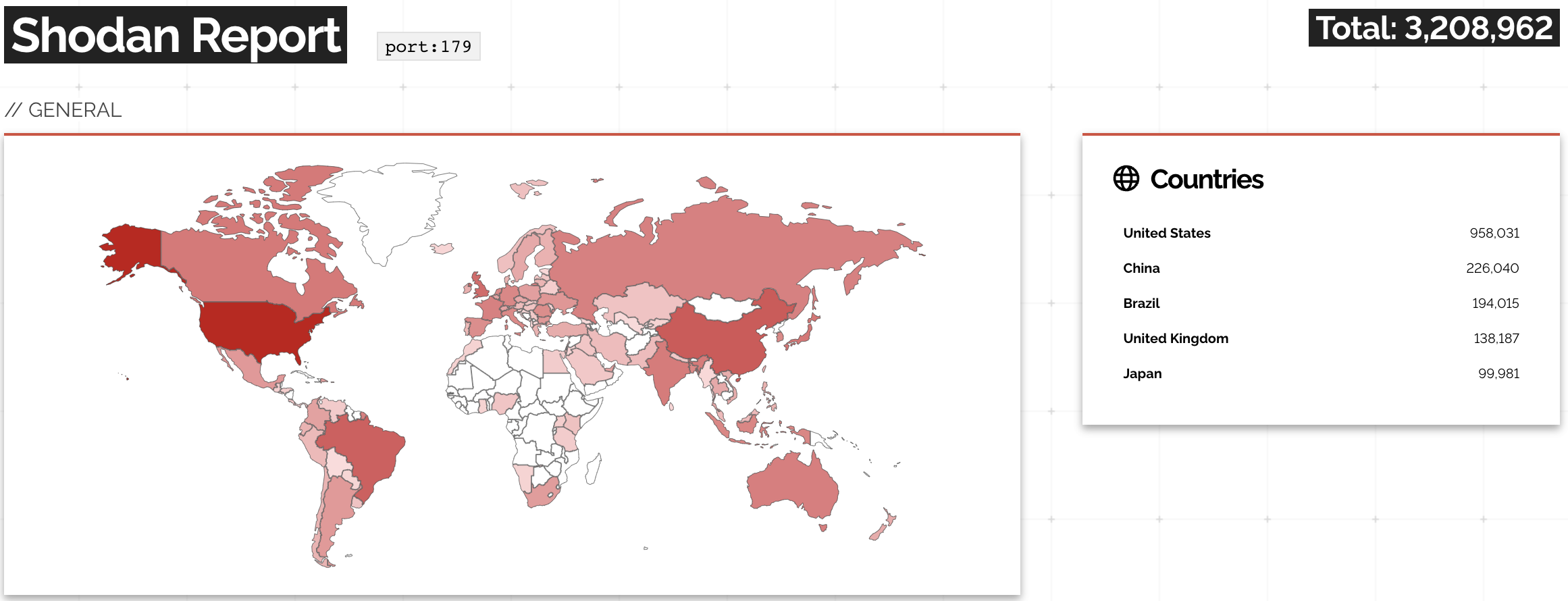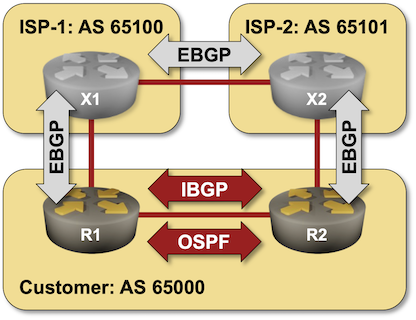Open BGP Daemons: There's So Many of Them
A while ago, the Networking Notes blog published a link to my “Will Network Devices Reject BGP Sessions from Unknown Sources?” blog post with a hint: use Shodan to find how many BGP routers accept a TCP session from anyone on the Internet.
The results are appalling: you can open a TCP session on port 179 with over 3 million IP addresses.

A report on Shodan opening TCP session to port 179
… updated on Wednesday, November 15, 2023 19:38 UTC
Rapid Progress in BGP Route Origin Validation
In 2022, I was invited to speak about Internet routing security at the DEEP conference in Zadar, Croatia. One of the main messages of the presentation was how slow the progress had been even though we had had all the tools available for at least a decade (RFC 7454 was finally published in 2015, and we started writing it in early 2012).
At about that same time, a small group of network operators started cooperating on improving the security and resilience of global routing, eventually resulting in the MANRS initiative – a great place to get an overview of how many Internet Service Providers care about adopting Internet routing security mechanisms.
Fibre Channel Addressing
Whenever we talk about LAN data-link-layer addressing, most engineers automatically switch to the “must be like Ethernet” mentality, assuming all data-link-layer LAN framing must somehow resemble Ethernet frames.
That makes no sense on point-to-point links. As explained in Early Data-Link Layer Addressing article, you don’t need layer-2 addresses on a point-to-point link between two layer-3 devices. Interestingly, there is one LAN technology (that I’m aware of) that got data link addressing right: Fibre Channel (FC).
Worth Reading: Confusing Git Terminology
Julia Evans wrote another great article explaining confusing git terminology. Definitely worth reading if you want to move past simple recipes or reminiscing about old days.
Video: Hacking BGP for Fun and Profit
At least some people learn from others’ mistakes: using the concepts proven by some well-publicized BGP leaks, malicious actors quickly figured out how to hijack BGP prefixes for fun and profit.
Fortunately, those shenanigans wouldn’t spread as far today as they did in the past – according to RoVista, most of the largest networks block the prefixes Route Origin Validation (ROV) marks as invalid.
Notes:
- ROV cannot stop all the hijacks, but it can identify more-specific-prefixes hijacks (assuming the origin AS did their job right).
- You’ll find more Network Security Fallacies videos in the How Networks Really Work webinar.
BGP Labs: Build a Transit Network with IBGP
Last time we built a network with two adjacent BGP routers. Now let’s see what happens when we add a core router between them:

Worth Reading: Taming the BGP Reconfiguration Transients
Almost exactly a decade ago I wrote about a paper describing how IBGP migrations can cause forwarding loops and how one could reorder BGP reconfiguration steps to avoid them.
One of the paper’s authors was Laurent Vanbever who moved to ETH Zurich in the meantime where his group keeps producing great work, including the Chameleon tool (code on GitHub) that can tame transient loops while reconfiguring BGP. Definitely something worth looking at if you’re running a large BGP network.
Weird: vJunos Evolved 23.2R1.5 Declines DHCP Address
It’s time for a Halloween story: imagine the scary scenario in which a DHCP client asks for an address, gets it, and then immediately declines it. That’s what I’ve been experiencing with vJunos Evolved release 23.2R1.15.
Before someone gets the wrong message: I’m not criticizing Juniper or vJunos.
- Juniper did a great job releasing a no-hassles-to-download virtual appliance.
- DHCP assignment of management IPv4 address worked with vJunos Evolved release 23.1R1.8
- There were reports that the DHCP assignment process in vJunos Evolved 23.1R1.8 was not reliable, but it worked for me so far, so I’m good to go as long as I can run the older release.
- I might get to love vJunos Evolved. Boot- and configuration times are very reasonable.
However, it looks like something broke in vJunos release 23.2, and it would be nice to figure out what the workaround might be.
Worth Exploring: BGP from Theory to Practice
My good friend Tiziano Tofoni finally created an English version of his evergreen classic BGP from theory to practice with co-authors Antonio Prado and Flavio Luciani.
I had the Italian version of the book since the days I was running SDN workshops with Tiziano in Rome, and it’s really nice to see they finally decided to address a wider market.
Also, you know what would go well with that book? Free open-source BGP configuration labs of course 😉
Early Data-Link Layer Addressing
After covering the theoretical part of network addressing (part 2, part 3), let’s go into some practical examples. I’ll start with data link layer and then move on to networking and higher layers.
The earliest data link implementations that were not point-to-point links were multi-drop links and I mentioned them in the networking challenges part of the webinar. Initially, we implemented multi-drop links with modems, but even today you can see multi-drop in satellite communications, Wi-Fi, or in cable modems.
BGP Labs: Multivendor External Routers
Here’s a quick update on the BGP Labs project status: now that netlab release 1.6.4 is out, I could remove the dependency on using Cumulus Linux as the external BGP router.
You can use any device that is supported by bgp.session and bgp.policy plugins as the external BGP router. You could use Arista EOS, Aruba AOS-CX, Cisco IOSv, Cisco IOS-XE, Cumulus Linux or FRR as external BGP routers with netlab release 1.6.4, and I’m positive Jeroen van Bemmel will add Nokia SR Linux to that list.
If you’re not ready for a netlab upgrade, you can keep using Cumulus Linux as external BGP routers (I’ll explain the behind-the-scenes magic in another blog post, I’m at the Deep Conference this week).
For more details, read the updated BGP Labs Software Installation and Lab Setup guide.
netlab 1.6.4: Support for Multi-Lab Projects; More BGP Goodies
Features in netlab release 1.6.4 were driven primarily by the needs of my BGP labs project:
- bgp.session plugin (formerly known as ebgp.utils plugin) got support for BFD, passive BGP peers and remove-private-as option.
- bgp.policy plugin implements basic BGP routing policy tools, including per-neighbor weights, local preference and MED.
- You can enable external tools in user defaults and use default groups to create user- or project-wide groups in the defaults files.
- Version-specific lab topology files allow netlab to select a lab topology that is a best fit for the netlab release you’re running.
Numerous platforms already support the new BGP nerd knobs:
Video: History of BGP Route Leaks
I’ll be talking about Internet routing security at the Deep conference in a few days, and just in case you won’t be able to make it1 ;) here’s the first bit of my talk: a very brief history of BGP route leaks2.
Note: you’ll find more Network Security Fallacies videos in the How Networks Really Work webinar.
BGP Labs: Build Larger Networks with IBGP
After going through the BGP basics, it’s time to build a network that has more than one BGP router in it, starting with the simplest possible topology: a site with two WAN edge routers.

… updated on Thursday, November 2, 2023 10:36 UTC
Will Network Devices Reject BGP Sessions from Unknown Sources?
TL&DR: Violating the Betteridge’s Law of Headlines, the answer is “Yes, but the devil is in the details.”
It all started with the following observation by Minh Ha left as a comment to my previous BGP session security blog post:
I’d think it’d be obvious for BGP routers to only accept incoming sessions from configured BGP neighbors, right? Because BGP is the most critical infrastructure, the backbone of the Internet, why would you want your router to accept incoming session from anyone but KNOWN sources?
Following my “opinions are good, facts are better” mantra, I decided to run a few tests before opinionating1.
